| | Compaction concerns | Effects of soil compaction | Importance of soil porosity | Identifying types of soil compaction | Surface soil crusting | Subsurface compaction | Wheel traffic-induced compaction | Topographical influence of soil compaction | Best management practices to prevent soil compaction | Summary
Soil compaction can be a serious and unnecessary form of soil degradation that can result in increased soil erosion and decreased crop production.
Compaction of soil is the compression of soil particles into a smaller volume, which reduces the size of pore space available for air and water. Most soils are composed of about 50 per cent solids (sand, silt, clay and organic matter) and about 50 per cent pore spaces.
Compaction Concerns
Soil compaction can impair water infiltration into soil, crop emergence, root penetration and crop nutrient and water uptake, all of which result in depressed crop yield.
Human-induced compaction of agricultural soil can be the result of using tillage equipment during soil cultivation or result from the heavy weight of field equipment. Compacted soils can also be the result of natural soil-forming processes. Solonetzic soils are an example of natural soil compaction (see Alberta Agriculture’s factsheet Agdex 518-8, Management of Solonetzic Soils).
This factsheet reviews several topics: the various types of human-induced compaction, the causes and consequences of soil compaction and prevention and management.
Effects of Soil Compaction
The various forces of soil compression by agricultural equipment can cause soil particles to become compacted closer together into a smaller volume. As particles are compressed together, the space between particles (pore space) is reduced, thereby reducing the space available in the soil for air and water. The compaction force may cause the crushing of soil aggregates, which has a negative affect on soil aggregate structure.
Soil compaction can have a number of negative effects on soil quality and crop production including the following:
- causes soil pore spaces to become smaller
- reduces water infiltration rate into soil
- decreases the rate that water will penetrate into the soil root zone and subsoil
- increases the potential for surface water ponding, water runoff, surface soil waterlogging and soil erosion
- reduces the ability of a soil to hold water and air, which are necessary for plant root growth and function
- reduces crop emergence as a result of soil crusting
- impedes root growth and limits the volume of soil explored by roots
- limits soil exploration by roots and decreases the ability of crops to take up nutrients and water efficiently from soil
- reduces crop yield potential
Compacted soil will restrict root growth and penetration into subsoil. This situation can lead to stunted, drought-stressed plants as a result of restricted water and nutrient uptake, which results in reduced crop yields.
In wetter than normal years, soil compaction can decrease soil aeration and lead to the increased loss of nitrate nitrogen by denitrification, which is the conversion of plant available nitrate-nitrogen into gaseous nitrogen forms that are lost to the atmosphere. This process occurs when soils are in an anaerobic condition and soil pores are mostly filled with water. Reduced soil aeration can affect root growth and function, and lead to increased risk of crop disease. All these factors result in increased crop stress and yield loss.
Importance of Soil Porosity
Soils consist of organic matter, various-sized soil particles referred to as soil texture (proportion of solid particles including sand, silt and clay) and pore spaces that contain air and water.
The connectivity of soil pores coupled with the size and number of pores is very important for water infiltration, water and nutrient movement within soil and the ability of the soil to hold water. Large, inter-connected soil pore spaces enhance several actions:
- water infiltration into soil
- water percolation into the root zone and subsoil
- air exchange with the atmosphere
Many important biological and chemical processes take place within soil pores that require both water and air. Reduced pore size and number will affect soil biological and chemical processes, such as the reduced cycling and release of plant available nutrients.
Soil compaction changes pore space size and distribution and will increase soil strength. One way to quantify the change is by measuring soil bulk density. This procedure is done by carefully taking a soil core and measuring the diameter and length to determine the volume of the core, then oven drying the core to determine the soil dry weight.
Soil bulk density is the dry weight of soil divided by the volume of the soil. It is usually expressed in grams per cubic centimeter (g/cm3). As the pore space is decreased within a soil, the soil bulk density is increased.
Normally, loam to clay loam soils have a bulk density of about 1.3 to 1.4 g/cm3, and sandy loam to loamy sand soils have a bulk density of 1.4 to 1.6 g/cm3. Naturally dense horizons in a Solonetzic soil will have bulk densities of1.6 g/cm3 or greater, and root growth will be hindered. Disced or cultivated surface soils will have bulk densities in the range of 1.0 to 1.2 g/cm3.
Heavily compacted soils contain few large pores and have a reduced rate of water penetration through the compacted layer. Large soil pores are the most effective in moving water through the soil. When large pores are absent, the hydraulic conductivity of soil (rate water will move through soil) will be greatly reduced.
In addition, the exchange of gases in soil with the atmosphere slows down in compacted soils, causing an increase in the likelihood of aeration-related problems. Soil compaction increases soil strength, which means plant roots must exert greater force to penetrate the compacted layer.
Identifying Types of Soil Compaction
Soil compaction can occur at the soil surface in the form of soil crusting, or it can occur in the subsoil. Soil compaction is sometimes blamed for reduced crop productivity, but it is important to correctly diagnose the cause or causes of reduced crop production. Poor plant growth can be caused by a number of factors, including soil compaction.
The first step is to correctly diagnosis if a soil compaction problem exists and then, develop short and long-term management practices to prevent further damage.
Soil compaction can occur at different times of the year through different mechanisms. Careful observations can help diagnose the problem:
- Is there poor crop growth in all years, with all crop types in the same area of the field?
- Is there a spatial pattern to the crop growth (associated with wheel tracks, windrows, equipment widths, haul trails)?
- Does the soil surface appear smooth and crusted?
- Has there been a change in equipment size, weight or operations?
- Are there soil types in the field with naturally dense horizons such as eroded knolls?
- If you scrape away the surface soil with a shovel or trowel, can you see dense layers and/or horizontal root growth?
Be aware that compaction of agricultural soils can be caused by various farming practices:
- Soil tillage that removes the protective residue from the soil surface, leaving the soil prone to natural environmental forces or excessive soil tillage that causes surface soil aggregates to break down or degrade, can lead to soil crusting, causing the surface soil layer to become hard and compacted.
- Soil tillage implements can induce soil compaction just below the depth of tillage, particularly when soils are wet.
- The weight of large farm equipment (tractors, seed carts, combines, trucks, manure spreaders) can cause wheel traffic compaction to a considerable depth within the root zone. As soil moisture content increases, so too does the depth of soil compaction.
Surface Soil Crusting
Compaction by combination of soil tillage and raindrop or irrigation water impact
Causes – Soil tillage can bury much of the protective residue cover on the soil surface and degrade the granular structure of surface soils (mechanical crushing or breaking of larger soil aggregates). The impact energy of rainfall or irrigation droplets can also cause considerable degradation and breakdown of soil aggregates, causing soil particles to become suspended in water, flow together and then dry into a hard surface soil crust. The crusted soil can restrict water infiltration into soil and restrict the emergence of germinating crops (Figure 1).
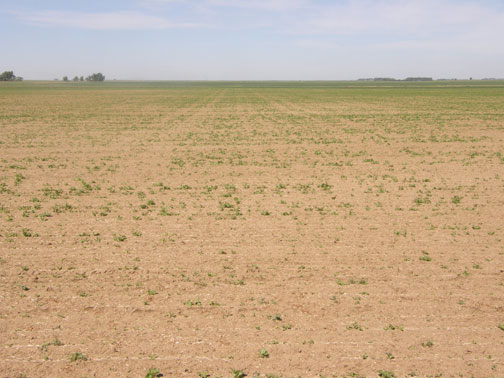
Figure 1. Soil crusting can severely reduce crop emergence as shown in this picture. However, poor emergence can also be caused by other factors such as feeding insects, too much seed-placed fertilizer or chemical residue.
Photo: R.H. McKenzie
Diagnosis – Crusted soils are relatively easy to diagnose by simply examining the soil surface to see if soil aggregates have broken down and a tough soil crust has formed. Visual examination of the soil crust may reveal a plate-like, horizontal layered structure. If a crust is observed after seeding and germinating seedlings are found that cannot break through the surface soil crust, then plant population can be greatly reduced, which will reduce plant stand and crop yield potential.
Correction and Prevention – A short-term emergence solution to soil crusting after seeding might be a light harrowing or rolling with packers to gently fracture the soil crust after seeding, to aid in seedling emergence through the crust.
Surface soil crusting is the result of leaving bare soil exposed to the forces of precipitation or irrigation water. The best way to prevent soil crusting in fields is to both minimize tillage operations and ensure that a protective layer of residue remains on the soil surface to absorb the impact of water droplets before they strike and break down stable soil aggregates. This can be achieved by reduced tillage or, preferably, by using direct seeding practices. These methods leave greater amounts of residue on the soil surface to reduce soil crusting and increase soil organic matter levels, leading to improved surface soil structure.
Using crop management practices such as including a forage in the crop rotation or using direct seeding practices to increase the levels of soil organic matter will aid in the development of a good granular-structured soil that has greater resistance to breakdown. In irrigated fields, it is also very important that water application is managed to ensure the infiltration rate of soil is not exceeded.
Subsurface Compaction
Hardpan tillage-induced compaction
Causes – A tillage-induced compaction layer is sometimes referred to as a “hardpan,” or “plow pan” and occurs in the layer of soil just below the depth of tillage. It occurs when soils are cultivated repeatedly at the same depth. The weight of the tillage equipment, such as discs or cultivator shovels, can cause compression of the soil and smearing at the base of contact between the soil and tillage implement (Figure 2). Usually the compacted layer is about 2 to 3 cm thick.
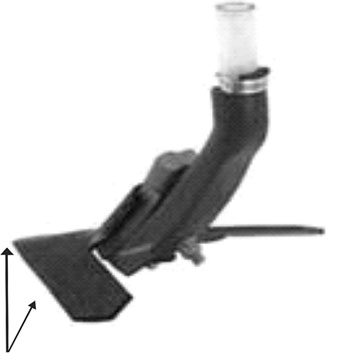
Figure 2. Soil compaction occurs at the base of the cultivator shovel or base of other types of tillage equipment. The level of compaction is increased as soil moisture content is increased or when the soil clay and silt content is higher.
Compaction will increase when soil moisture conditions are wet at the time of tillage and/or if soils have a higher silt and clay content. In extreme cases, the compaction can be quite serious, affecting water and root penetration into the subsoil. However, with coarser textured soils, the hardpan tends to be weaker and more friable, and may not affect crop production.
Diagnosis – The occurrence of a hardpan can be determined by using a shovel or trowel to carefully shave away the tilled surface soil to the depth of the tillage layer, until the top of the hardpan is exposed. The hardpan can be examined visually to see if plant roots are growing horizontally along the surface of the hardpan, which is a very good indicator that roots are having difficulty penetrating the hardpan. Figures 3 and 4 provide pictures of the top of tillage-induced compaction.
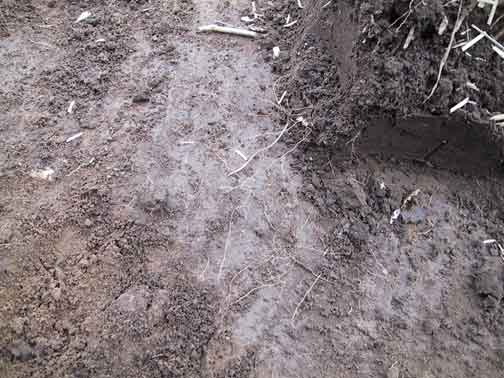
Figure 3. Exposed tillage hardpan with roots growing horizontally along the hardpan.
Photo: R. Dunn
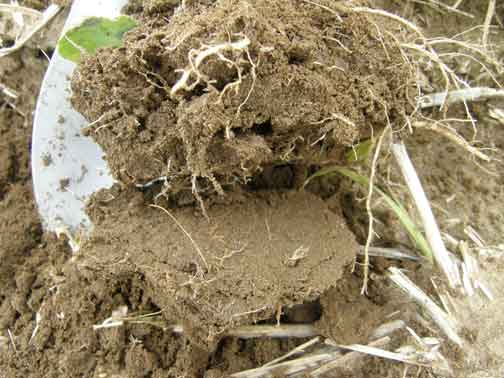
Figure 4. Exposed tillage hardpan.
Photo: R.H. McKenzie
Correction and Prevention – It has generally been assumed that compacted soil layers break down naturally with annual freeze-thaw and wetting-drying cycles. When compacted soil persists, the soil may need some form of tillage to physically break up the hardpan.
When soils are relatively dry, use a heavy-duty cultivator with spikes to penetrate just below the hardpan to fracture and break it up. Generally, this tillage should take place in the fall when soils are dry; however, great care is needed to maintain residue on the soil surface to prevent soil erosion and not intermix subsoil with topsoil.
It is important to note that tillage may reduce the hard pan compaction problem, but it may not address the sources of the problem. It may take three to five years of reduced tillage or direct seeding practices, freeze-thaw cycles and the use of a combination of taproot and fibrous-rooted crops to correct the hardpan problem. It is very important to note that deep ripping equipment should not be used to correct this form of soil compaction.
To avoid the development of a tillage-induced hardpan, land should be direct seeded to minimize tillage of the soil. If soil must be tilled, great care is needed to ensure soils are not too moist to avoid tillage-induced compaction. Further, for soils that must be cultivated, the development of a hardpan can be reduced by varying the depth and direction of tillage for each cultivation. For land seeded to row or root crops, where tillage is required, soils should not be worked when wet.
Wheel Traffic-induced Compaction
Causes – Heavy farm equipment, including tractors, grain carts, combines, trucks, manure spreaders and wheels of pivot irrigation systems, can exert considerable weight onto the soil surface and, consequently, into the subsoil. The effect of equipment weight can penetrate down to 60 cm (24 inches) when soils are moist.
The concern of wheel traffic compaction has increased in the past several decades due to the increasing size of farms, farm equipment and the time needed to complete farm operations at seeding and harvest. Tractor size and weight has increased to 15 to 20 tonnes for four-wheel-drive tractors and fully loaded air seeder carts. The weight of a full combine can be in the range of 15 tonnes.
Therefore, with the increasing axle weight of equipment, care is needed when soils are quite moist to minimize the potential for wheel traffic compaction. In spring, when soil moisture conditions tend to be higher, the risk of soil compaction is often the greatest. Figures 5 to 8 demonstrate the effect of wheel traffic-induced compaction.
Figure 5. Wheel traffic compaction. The depth of compaction increases with increasing equipment weight (axle load) or increasing moisture condition. (Adapted from Soehne, 1958. Journ. of Agr. Eng.)
Source: University of Minnesota Extension Publication WW-03115; Available on-line at: http://www.extension.umn.edu/distribution/cropsystems/components/3115s01.html#section1
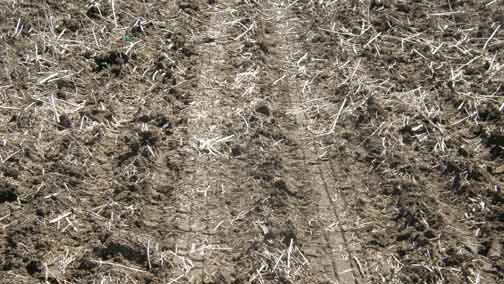
Figure 6. Visible wheel traffic compaction on surface soil from air seeder cart. Generally, this type of compaction may reduce crop emergence but not significantly affect soil compaction.
Photo: R.H. McKenzie
Diagnosis – Examining crops growing in a field can help diagnose wheel track compaction problems by the evidence of reduced crop growth in wheel track areas. A key diagnostic is the linear feature of poor crop in line with wheel spacing of heavier equipment.
A shovel can be used to dig up plants in affected and unaffected areas. Carefully examine plant roots from healthy, unaffected crop areas versus those from problem areas to see if growth is being affected by compaction. Plants from compacted areas may have malformed or restricted root development. Roots from a compacted soil area may also be confined to the top layer of soil with minimal penetration into the subsoil.
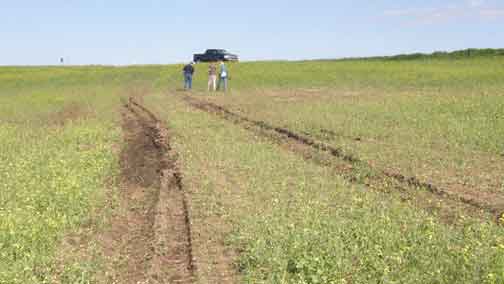
Figure 7. Visible wheel traffic compaction on soil surface from sprayer in wetter areas of a field.
Photo: R.H. McKenzie
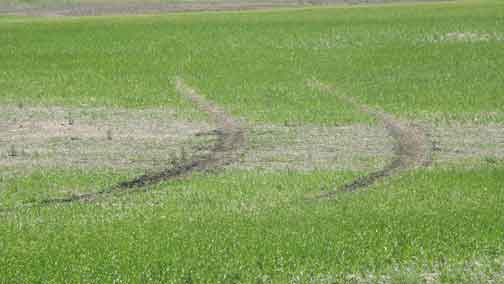
Figure 8. Wheel traffic compaction in lower, wet area of field and no visible compaction elsewhere.\
Photo: R.H. McKenzie
A soil penetrometer (Figure 9) can be used as a diagnostic tool to measure the extent and depth of subsurface soil compaction. Normally, only researchers and agricultural consultants have this type of expensive diagnostic equipment and the knowledge and experience to use it correctly.
Figure 9. Soil penetrometer used for determining compacted soil horizons.
A soil penetrometer consists of a 30-degree steel cone at the end of a steel shaft and a pressure gauge on the other end. The gauge reads in pounds per square inch (psi), usually up to 400 to 500 psi.
The penetrometer is normally pushed into the soil at a rate of 2.5 cm (1 inch) per second. Readings of 400 to 500 psi would indicate potential soil compaction. Make sure the areas compared with the probe have a similar soil moisture content.
If compacted areas are detected, the next step is to use a shovel to dig soil pits to examine the soil or to use a hydraulic soil coring unit to examine problem areas and confirm the soil is compacted. A soil texture change or a dry soil layer can mimic compaction when using a penetrometer, but there may not necessarily be a compacted soil layer. It is critically important to use more than just a penetrometer to diagnose soil compaction.
Correction and Prevention – Wheel traffic-induced compaction can be managed using good agronomic practices, deep tillage or a combination of both. Ideally, it is best to use agronomic practices both to prevent and correct wheel traffic compaction.
A good preventative management practice is to avoid having equipment repeatedly travel on the same wheel tracks. For example, avoid having grain trucks use the same path into and out of the field. Instead, shift over and drive on a new path each time in the field. Another suggestion is to load seeders and unload combines on the headlands of fields to reduce the traffic in the field.
A good agronomic option is to plant a deep-rooted crop, such as alfalfa (see Figure 10), to penetrate a compacted soil layer and utilize natural wetting-drying and freeze-thaw cycles to mellow the soil. Great care is needed to avoid traffic on the land when soils are quite moist.
In situations where wheel traffic has created compaction to a depth of 30 to 50 cm (12 to 20 inches), there may be a need to loosen the compacted soil using deep tillage to fracture the compacted soil zone. When soil compaction is at a depth below 50 cm (20 inches), deep tillage is relatively ineffective to reduce compaction as most implements are not able to penetrate much below 50 cm.
It is important to recognize that using mechanical deep tillage is only a short-term solution to soil compaction and is very expensive. It is costly to purchase or rent specialized deep tillage equipment, and the operating costs are also expensive; therefore, it is very important to diagnose this problem correctly. Ultimately in the long term, agronomic practices must be adopted to minimize wheel traffic compaction.
Deep tillage implements have been developed to effectively loosen compacted soil layers. However, some conventional subsoilers or deep rippers cause considerable mixing of soil layers. Great care is needed to select a tillage implement that does not inter-mix soil layers.
One type of implement that works more successfully has shanks slanted at a 45 degree lateral angle. As the angled shanks slice through dry soil, the soil is lifted slightly, shifted to the side and dropped back into place. This lifting-shifting-dropping action fractures the dry soil to reduce the soil density. Some units have adjustable shatter-plates behind the shanks to increase or decrease the disturbance of the soil.
It is critically important that the soil profile be dry to achieve the necessary fracturing to loosen and reduce the density of the soil. Ideally, implements must leave the soil surface relatively undisturbed, and leave topsoil and subsoil unmixed. Ideally, a crop can be direct-seeded without the need for additional soil cultivation.
To minimize wheel traffic-induced soil compaction, producers should consider the following strategies:
- Minimize traffic on fields when subsoil is wet.
- Minimize axle loads by increasing the number of tires on an axle on an implement.
- Use the lowest acceptable tire pressure.
- Tracked vehicles give better weight distribution versus implements with tires, but care is needed to minimize track slippage, which could cause increased surface soil problems.
- Use headlands for heavier equipment and traffic. Where possible, try to unload and load on the headlands to avoid driving carts and loaded trucks through the field. This practice will help limit the compaction areas to just the headland areas.
Adverse effects of deep tillage
Use deep tillage with great caution. Although deep tillage can be beneficial under specific soil conditions, its use can also have very serious negative effects on soil quality. Therefore, the use of deep tillage must be considered carefully. Some potential concerns:
- Some rippers cause greater mixing of surface soil with subsoil, which results in the deterioration of soil structure, reduction in soil organic matter, reduced soil fertility and increased potential for surface soil crusting. These conditions can be much worse than minor soil compaction problems.
- Loss of plant available moisture can occur.
- Soluble salts in subsoil can be intermixed with surface soil, increasing salt levels and reducing crop yield potential.
- Subsoiling can make the ground surface rough and lumpy and can pull rocks to the surface. This potential outcome includes implements that claim to cause lower surface soil disturbance.
- A subsoiled field will often have a poor seedbed the following year due to an uneven and soft surface soil and reduced soil moisture conditions.
- If high or excessive amounts of moisture are received after subsoiling, the fractured soil zones can become waterlogged and unmanageable until dry.
Before attempting to deep rip a field, a producer must carefully consider the potential negative consequences. Ideally, a producer should try ripping in several test strips in a field to evaluate the benefits and risks over one or even two years before deep ripping an entire field.
Topographical Influence on Soil Compaction
Fields with variable or rolling landscapes may have soils in hilltop areas that are naturally more compacted. Soils developed on hilltops are usually characterized by shallow surface soil layers, low organic matter and compacted subsoil layers (higher bulk density). This is a form of natural soil compaction due to the way soil material was deposited by glacial action.
Naturally compacted subsoil layers can greatly reduce crop productivity by reducing water infiltration and crop root penetration. Over years of cultivation, the loss of surface soil as a result of tillage, coupled with water and/or wind erosion, results in the exposure of more compacted subsoil layers at the soil surface, leading to field areas with soil compaction problems and poor tilth.
The movement of soil from upper slopes and the deposition onto lower slopes will result in varying depths of topsoil. This action affects field productivity through the translocation of soil from upper to lower slopes, altering soil nutrient levels, water storage capacity and organic matter levels.
Poor soil management practices can increase the rates of wind, water and tillage erosion so that soils are redistributed, resulting in even greater soil variability on rolling landscapes.
The effects of compacted subsoil layers are compounded by accelerated soil erosion, which results in delayed crop emergence, reduced plant development and reduced straw and grain yield. Higher soil bulk density in compacted soils of surface and subsurface horizons affects root development by mechanically impeding growth and reducing oxygen availability within the root zone.
The combination of soil erosion and soil compaction can be improved through the application of nitrogen and phosphorus fertilizers, manure and the integrated use of organic amendments. The adoption of a zero-till, continuous cropping system has the greatest benefit on eroded knolls of a rolling landscape in several ways: improved soil quality, increased organic matter and improved soil structure and water infiltration capacity, which reduces surface runoff from rainfall and limits the transport of nutrients and herbicides to surface waters.
For further information on eroded knoll management, refer to Alberta Agriculture’s factsheet, Fertilizing Eroded Knolls, Agdex 541-2.
Best Management Practices to Prevent Soil Compaction
Ideally, farmers should design their soil management and cropping practices to ensure the prevention of soil compaction:
- Use direct seeding practices to increase soil organic matter content, which will optimize soil structure.
- Reduce the potential for the development of compacted soils by eliminating cultivation and reducing traffic in fields, which will increase crop water use efficiency and increase crop yield potential.
- Take advantage of the natural soil processes of “wetting-drying” and “freeze-thaw” cycles to minimize the effects of soil compaction. For irrigated areas, fall irrigation may ensure sufficient water for the freeze-thaw effects.
- Use a combination of fibrous and taprooted crops in a rotation to penetrate soils, develop deep root channels and add organic matter to soil (Figure 10).
Direct Seeding
It is best to manage soils and crop rotations to prevent the development of compacted soils through good agronomic management and by implementing basic soil conservation practices.
As mentioned in the “Soil Crusting” section, reduced tillage or preferably using direct seeding practices, all of which leave greater amounts of residue on the soil surface, will reduce soil crusting and will increase soil organic matter levels. A protective layer of residue on the soil surface will absorb the impact of water droplets and prevent the breakdown of soil aggregates. Direct seeding will also aid in increasing soil organic matter and help develop a good granular-structured soil that has greater resistance to aggregate breakdown.
Direct seeding will eliminate the need for soil cultivation, which is the primary cause for development of a hardpan or plow pan layer. Direct seeding will also reduce the amount of wheel traffic and, therefore, the amount of wheel traffic compaction on soils.
Figure 10. Taproot of canola on left versus fibrous root of pea on right.
Photos: R. Dunn
Controlled Traffic Farming
Controlled traffic farming is a new cropping system practice in which tramlines are set so that all farm machinery traffic travels in the same wheel tracks in a field. The system separates the tramlines from the crop areas. As a result, the traffic lanes where all machinery travels are permanently set up within a field.
A farmer would have to modify all seeding, spraying, harvest and other equipment to use the same wheel gauge (distance between wheels across the machine). For example, a farmer might modify equipment to have a 30-foot-wide seeder, 30-foot-wide header on a combine and 90-foot-wide sprayer, all running on the same wheel gauge on the same tramlines.
This practice would result in wheel traffic compaction only in the tramlines within the field and not in the rest of the field. This cropping system practice would have long-term capital investment considerations for a farmer.
Those promoting the controlled traffic farming concept suggest the following benefits:
- reduce overall soil compaction in a field
- improve soil structure
- increase water infiltration
- increase soil water storage
- increase moisture use efficiency
- improve nutrient use efficiency
Although the practice of controlled traffic farming is being promoted in Alberta, the technology and its various claims have not been demonstrated or proven scientifically on the Canadian prairies. Therefore, the adoption of this practice should be approached with caution. Most agricultural fields likely do not have sufficient soil compaction problems to warrant the adoption of this management practice.
Several risks may develop by following this practice. For example, tramlines may become quite compacted over time and produce little or no crop yield in those areas, which would result in reduced total productivity in a field.
Increased water erosion could occur along tramlines, particularly on fields with greater than 2 per cent slopes. In wetter years, increased compaction and rutting on the tramlines could be a problem.
Currently, there is little evidence to suggest that controlled traffic farming in an Alberta situation would be better than simply using good soil conservation and crop management planning for the prevention of soil compaction problems.
Crop rotations and management
Using diverse crop rotations, which include forage, cereal, oilseed and pulse crops that vary in rooting depth and type (fibrous versus taproot), combined with good agronomic management practices, such as direct seeding will help reduce soil compaction issues.
Good cropping practices will help in several ways:
- promote plant roots to grow through and break up compacted soils
- increase soil organic matter
- improve soil structure, improve water infiltration and penetration into soil
- promote biological diversity
A biologically healthy soil will be more resistant to soil compaction.
Summary
Soil compaction is not considered a widespread, serious problem in Alberta. However, soil compaction can be a serious and unnecessary form of soil degradation. Preventing soil compaction is far better than trying to correct a compaction problem after it occurs.
A number of management options can be implemented to minimize the risk of soil compaction:
- Keep a protective residue cover on the soil surface to reduce the negative effects of rain or irrigation water causing soil crusting.
- Minimize or eliminate soil tillage to prevent soil aggregate breakdown and induce the development of a tillage “hardpan” – this goal can be achieved by direct seeding and the elimination of soil cultivation.
- As far as possible, avoid field traffic when soils are wet; this is more easily said than done, for example, when harvest schedules dictate the crop must come off despite wet field conditions.
- Reduce the wheel traffic load on the soil, which can be done by keeping axel loads to a minimum. Use radial tires at low inflation pressures to create a larger footprint.
- Minimize the field traffic areas on fields. Load wagons or trucks on a road (if it can be done safely) or on headlands.
- Improve soil organic matter and soil structure, and increase biological activity in soil by using best agronomic management practices.
Prepared by
Ross H. McKenzie Ph.D., P.Ag.
Research Scientist – Agronomy
Agriculture Research Division
Alberta Agriculture and Rural Development
Lethbridge, Alberta
Telephone: 403-381-5842
The author would like to acknowledge the contributions and review by Alberta Agriculture and Rural Development staff: Shelley Woods, Rob Dunn, Trevor Wallace, Len Kryzanowski, Mike Bevans, Blaine Metzger and Tom Goddard.
For further information, contact
Alberta Ag-Info Centre
Call toll-free in Alberta at 310-FARM (3276)
Source: Agdex 510-1. October 2010. |
|